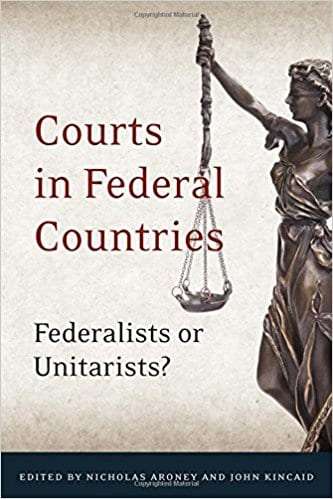The Volokh Conspiracy
Mostly law professors | Sometimes contrarian | Often libertarian | Always independent
Courts in Federal Countries: Federalists or Unitarists?

The battle over the U.S. Supreme Court seat left vacant by Antonin Scalia's death highlights once again just how political the Court is today. Is this true worldwide? Not necessarily. Party politics influence the makeup and jurisprudence of high courts in all federal systems, but not all courts are as politicized as the U.S. Court.
In our edited volume, Courts in Federal Countries: Federalists or Unitarists? (University of Toronto Press 2017), experts examine the structure, operation, and federalism jurisprudence of the supreme or constitutional court (or lack thereof) in Australia, Belgium, Brazil, Canada, Ethiopia, Germany, India, Mexico, Nigeria, South Africa, Spain, Switzerland, and the United States.
No high court consistently favors decentralization. Most lean strongly or moderately toward centralism, partially confirming Anti-Federalist Brutus's fear that the U.S. Supreme Court would "lean strongly in favor of the general government." As Ilya Somin notes in his chapter, the U.S. Court has, on balance, strengthened the national government at the expense of the states.
Two partial exceptions are the constitutional courts of Belgium and Germany. They have generally balanced centralization and decentralization over time. Tellingly, the federal Supreme Court of Switzerland, which doesn't exercise judicial review over federal law, avoids finding cantonal legislation unconstitutional whenever possible.
Where constituent-unit boundaries correspond with robust cultural identities-as in Belgium, Canada, Spain, and Switzerland-judicial centralization is more restrained, though not halted, than in federations such as Australia and the United States. However, the mode of judicial selection has a significant impact, too. Where the constituent units play a more direct role in appointments, as in Germany, the high court is less centralist.
Political parties influence the composition and orientation of all federal high courts but in complex ways. This occurs most clearly where there is a dominant federation-wide party, as in South Africa, that pushes the high court in a centralist direction. In Ethiopia, which is the only federation having no high court authorized to adjudicate intergovernmental issues (that function is assigned to the House of Federation), federal-state-local disputes are settled within the structure of the dominant party coalition (the EPRDF) that controls the country. By contrast, the decline of the Congress Party and rise of multiple state-based parties in India since 1989 have nudged India's Supreme Court in a mildly decentralist direction.
More centralized federal constitutions usually generate more centralist high-court jurisprudence, but judicial centralization is more restrained when the federal constitution expressly lists the powers of both the national and constituent governments. A judicially enforced bill of rights, however, encourages centralist rulings.
History influences both the design of federal constitutions and the orientation of high courts. Brazil and Mexico, for instance, had centralized and authoritarian regimes prior to federalization. Those traditions still influence their high courts' centralist orientations. In Germany, though, one finds reactions against the country's Nazi past. Some high courts contribute to redirections of historical and cultural trajectories.
We also find differences between "integrative" and "devolutionary" federal systems. Integrative federations, such as Australia, Switzerland, and the United States, are created by unions of previously independent states. Devolutionary federations, such as Belgium and Spain, arise when regions within a formerly unitary state demand self-government. In integrative systems, especially where there is regional homogeneity, the tendency is to centralize. In devolutionary systems, especially where there is regional heterogeneity, the tendency is to decentralize.
Other important jurisprudential issues examined in the book are whether the people of a federation regard themselves as multiple demoi or as a single demos and whether sovereignty is understood to reside in the people of the federation as whole or in the separate constituent peoples, as suggested by the opening of Ethiopia's constitution: "We, the Nations, Nationalities and Peoples of Ethiopia."
Meanwhile, Switzerland and Ethiopia challenge the assumption that a high court exercising judicial review is necessary for a viable federation or federal democracy. Ethiopia is not democratic and may not, in the long run, be a viable federation, but perhaps the Swiss had the right idea of leaving it to the people, not a high court, to be the ultimate arbiter of de/centralization.
It is worth recalling that Alexander Hamilton, who dubbed the federal judiciary "the least dangerous" branch, believed that the people, not the Supreme Court, would play the vital role of regulating "the constitutional equilibrium between the General and the State Governments" (Federalist 31) through the House of Representatives because only the House is constitutionally authorized to originate revenue bills to levy taxes to swell federal power.
(We thank the government of Québec and Forum of Federations for essential financial and logistical support in producing this book.)


Show Comments (0)